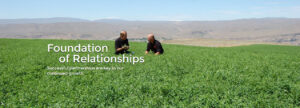How Do Horses Digestion Systems Work?
Horses are non-ruminant herbivores, meaning they have a single stomach digestive system, and can eat and  utilize roughages much like cattle or sheep. However, unlike cattle, horses have stomachs that function similarly to human stomachs, where feed particles are mixed with pepsin, an enzyme that breaks down proteins, and hydrochloric acid, which breaks down solid particles. But, a horse stomach is quite small in comparison to the stomachs of other livestock animals and can only contain about 10% of the total capacity of the digestive system.
utilize roughages much like cattle or sheep. However, unlike cattle, horses have stomachs that function similarly to human stomachs, where feed particles are mixed with pepsin, an enzyme that breaks down proteins, and hydrochloric acid, which breaks down solid particles. But, a horse stomach is quite small in comparison to the stomachs of other livestock animals and can only contain about 10% of the total capacity of the digestive system.
Because of the limited capacity of its stomach, a horse should be fed small amounts of feed often. Unfortunately, domesticated horses are fed once or twice a day and if stabled, spend much of the day not eating. Because hydrochloric acid is produced continuously in the horse stomach, it can accumulate in an empty stomach, irritate the stomach lining, and eventually cause ulcers.
After feed leaves the stomach, it passes into the small intestine where much of the soluble carbohydrates, or sugars, and protein from grain are digested and absorbed. From there, feed passes to the large intestine, which is made up of the cecum and large colon. The cecum is a blind sac that is essentially a 10-gallon fermentation vat containing millions of microorganisms that break down the fibrous components of roughages. Microbial breakdown of fibrous particles continues in the large colon where water is also absorbed and fecal balls are formed and passed through the rectum.
Passage rate through the small intestine to the large intestine is quite rapid and if a large amount of grain, which contains high levels of soluble sugars, is ingested, the capacity of the small intestine is quickly overwhelmed. When high levels of soluble carbohydrates reach the large intestine, they are rapidly fermented, resulting in overproduction of gas and lactic acid, which can lead to colic and laminitis, respectively.
How Much and How Often Horses Should Eat
So, in order to maximize digestive efficiency and prevent digestive upset a horse should be fed several small meals throughout the day. But, do you know how much your horse is supposed to eat every day? The answer to this question depends on the physiological status of the animal (if it is growing, pregnant, or lactating) and on the work level of the horse.
However, let’s consider the typical pleasure horse that works 1 – 3 hours a week. The daily dry matter intake of an adult horse performing light work should be about 1.8% of its body weight each day. At least 65% of this amount should be forage.
In other words, a 1,000 lb horse should be fed 18 pounds of dry matter each day. Dry matter (DM) is the amount of feed that does not contain moisture; the DM content of hay is considerably higher than fresh grass. Note: the hay analysis should show the DM content of your forage. If you are feeding 100% hay and your hay contains 90% DM (or 10% moisture), your 1,000 lb horse should be fed 20 pounds of hay (18 lb DM/0.9) straight from the bale each day.
How to Properly Measure Hay
Weighing hay is the most effective way to measure the correct amount. However, more than 85% of horse owners who completed a survey published in the Journal of Equine Veterinary Science (1) reportedly measured the amount of hay fed by flakes. Flakes of hay vary widely in weight, depending on forage type, size and tightness of bales; therefore, measuring hay by this method can result in misrepresentation of forage amount. The same can be said for measuring concentrates. A coffee can or a scoop of grain is an arbitrary amount. A scale with a capacity of at least 10 pounds is a must in all horse barns! You can certainly measure feed quantities by flakes of hay or coffee cans of grain after you determine how much each of those units actually weighs.
In summary, in order to maximize feed utilization efficiency and avoid digestive upsets, a horse should be fed an accurately weighed amount of feed based on its size, physiological status and work load. Ideally, this amount should be fed in small meals at frequent intervals throughout the day.
What method do you use to monitor your horse’s daily intake? Have you found a good hay scale? Tell us about it in the comments section!
References
Description of equine digestive system was adapted in large part from:
Parker, R. 2003. Equine Science, 2nd Edition. Delmar Learning, Clifton Park, NY.
(1) Hoffman, C.J., L.R. Costa, and L.M. Freeman. 2009. Survey of feeding practices, supplement use, and knowledge of equine nutrition among a subpopulation of horse owners in New England. J. Equine Vet. Sci. 29:719-726.


